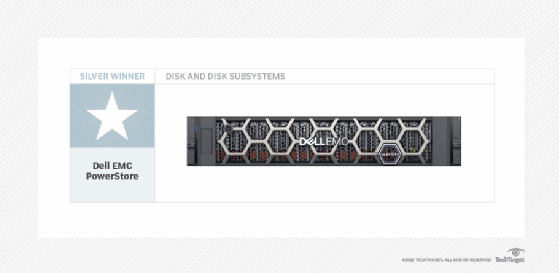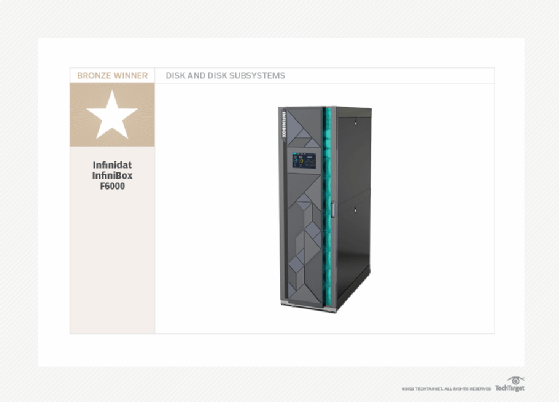
kentoh - Fotolia
The best enterprise storage arrays of 2020
Vast Data, Dell EMC and Infinidat show that flash storage rules the data center in the 'Storage' magazine and SearchStorage Products of the Year 2020 disk and disk subsystems category.
Prize-winning vendors in the Storage magazine and SearchStorage 2020 Products of the Year disk and disk subsystems category illustrate how flash technology has surged to prominence in enterprise storage arrays.
The entries in our disk and disk subsystems category included products that use fixed disk, flash, hybrid, multiprotocol and converged infrastructure systems; SSDs; HDDs; disk controllers; and caching appliances. To be considered, a vendor's flash product must integrate software management with storage features in the storage media.
Flash is ubiquitous in large organizations, and an increasing contingent of midsize enterprises are using it. Falling flash prices make it easier to justify the switch from disk-based enterprise storage arrays to solid-state media. Increasingly, IT shops have chosen to sprinkle hybrid flash storage in core data centers, cloud arrays and network edge devices.
Our 2020 winners include a repeat gold winner that serves all data from flash, a new midrange array from the networked storage market leader, and a disk array vendor that added an NVMe over TCP flash fabric to its enterprise storage array hybrid architecture.
Gold winner: Vast Data LightSpeed
Vast Data Inc. earned the top slot from our judges for the second year in a row. The startup touts flash as the only storage tier users need. The company's LightSpeed NAS appliance extends its disaggregated Universal Storage platform to serve primary and secondary data from pooled flash.
One judge described Vast Data LightSpeed as "one of the most innovative storage architectures on the market." It's "no easy task" to build a functional system that combines Intel Optane persistent memory, NVMe flash and quad-level cell (QLC) NAND SSDs, the judge added.
Vast's Universal Storage was one of the earliest all-flash systems to use Intel Optane 3D XPoint memory as a front end to QLC NAND. Vast claims its storage system delivers flash performance at the lower price of disk.
The Vast Data LightSpeed update to the Universal Storage system is "narrowly aimed at the high-performance computing market," where expectations are different from those of enterprises, another judge said.
"Vast is in the middle of the extreme performance market, with price points to match. [LightSpeed] is a good, solid effort, and it's important -- just not market-changing," a second judge said.

LightSpeed is rated to deliver two times the computing power of Vast's previous hardware. The 2U NVMe-enabled enclosure incorporates Nvidia's GPUDirect Storage to write data via NFS to Nvidia supercomputers.
All I/O requests are served in real time to prevent AI processors from becoming a system bottleneck. Vast's algorithms optimize the efficiency of the flash.
Vast Data LightSpeed comes in two-, five- and 10-node cluster configurations to scale storage capacity with performance.
Silver winner: Dell EMC PowerStore
After several delays, the Dell EMC PowerStore midrange enterprise storage array made its debut in April 2020, rounding out a portfolio-wide refresh under the Dell Power brand.
The PowerStore midrange array is the first new storage product developed internally since the Dell-EMC merger in 2015. Dell EMC is counting on PowerStore to prop up sales and help streamline its overlapping midrange portfolio.
Along with end-to-end NVMe flash, PowerStore supports dual-port Intel Optane SSDs and Intel Optane storage class memory cards. Until now, Dell EMC Unity was the vendor's flagship midrange line. Compared with Unity systems, Dell EMC rates PowerStore to deliver seven times the performance and a threefold reduction in latency.
The scale-out and scale-up PowerStore supports block and file data as well as virtualized storage management with VMware Virtual Volumes. With Dell's Anytime Upgrades feature, users can refresh controllers at any point during a service contract.

Native integration with Dell-owned VMware includes an onboard ESXi hypervisor. A new feature, AppsOn, uses VMware vMotion to migrate virtualized applications between PowerStore arrays and cloud environments. The VMware components in PowerStore "set this apart and provide a new deployment model for data-intensive workloads," one judge said.
With the PowerStore Manager wizard, users can nondisruptively migrate data from existing Dell EMC Unity, SC Series, PS Series, VNX and XtremIO storage systems.
Each active/active PowerStore appliance can grow to more than 2.8 petabytes (PB) of effective capacity, and multiple appliances can be clustered for more performance. Inline compression and deduplication operate continuously. Dell EMC hardware acceleration guarantees a data reduction ratio of at least 4-1.
Bronze winner: Infinidat InfiniBox F6000
The Infinidat Inc. InfiniBox F6000 enterprise storage array features three key system enhancements: redundant replication, out-of-the-box NVMe fabric capabilities and elastic pricing.
"NVMe-oF is the headline feature here and [is] used to good effect to provide rapid scalability, usage-based pricing and multisite replication," said one judge of Infinidat's entry.
The replication and cloudlike buying model, along with AI-enhanced caching, "provide a storage system that combines performance, functionality and cost advantages," another judge said.
The Infinidat array is aimed at organizations that have petabytes of data storage but may not have the budget for all-flash storage. A single InfiniBox rack scales to 4.1 PB of usable capacity.

The InfiniBox OS directs all writes to HDDs. Flash accounts for approximately 3% of the overall capacity and is used to accelerate back-end access to disk-based cold storage.
The Infinidat InfiniBox neural cache uses deep learning algorithms and a "trie" data structure to intelligently decide which data to prefetch in read cache. All writes, and nearly all reads, occur at dynamic RAM or SSD speed for extremely low latencies. Like Vast Data, Infinidat claims its system provides flash performance at the cost of disk.
Infinidat claims its multisite replication concurrently provides recovery point objectives (RPOs) and recovery time objectives at zero in metro areas. Data also is asynchronously replicated with near-zero RPO to multiple backup sites distributed geographically.
Despite its disk legacy, Infinidat implemented NVMe flash driver software to use TCP/IP as a native NVMe-oF fabric. That gives data centers a way to deploy NVMe-oF without modifying the existing network infrastructure.
Read more about the gold, silver and bronze winners in each of the five Storage magazine and SearchStorage 2020 Products of the Year categories.




